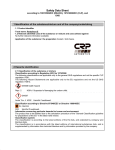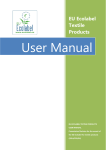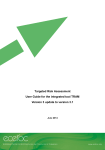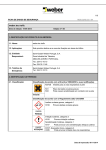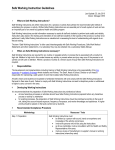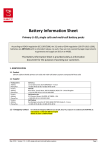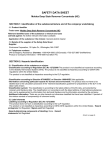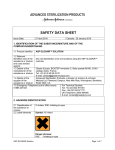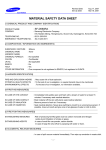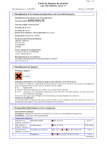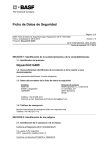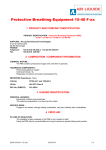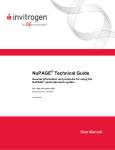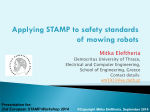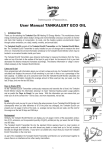Download Pentosin® Pentofrost A1 Antifreeze Material Safety
Transcript
37.0.1 Safety Data Sheet according to 1907/2006/EC (REACH), 1272/2008/EC (CLP), and GHS 1 Identification of the substance/mixture and of the company/undertaking · 1.1 Product identifier · Trade name: Pentofrost A1 · 1.2 Relevant identified uses of the substance or mixture and uses advised against No further relevant information available. · Application of the substance / the preparation Coolant / Anti-freeze. 2 Hazards identification · 2.1 Classification of the substance or mixture · Classification according to Regulation (EC) No 1272/2008 GHS07 Acute Tox. 4 H302 Harmful if swallowed. Eye Irrit. 2 H319 Causes serious eye irritation. · Classification according to Directive 67/548/EEC or Directive 1999/45/EC Xn; Harmful R22: Harmful if swallowed. Xi; Irritant R36/38: Irritating to eyes and skin. · Information concerning particular hazards for human and environment: The product has to be labelled due to the calculation procedure of the "General Classification guideline for preparations of the EU" in the latest valid version. · Classification system: The classification is according to the latest editions of the EU-lists, and extended by company and literature data. The classification is in accordance with the latest editions of international substances lists, and is supplemented by information from technical literature and by information provided by the company. · 2.2 Label elements · Labelling according to Regulation (EC) No 1272/2008 The product is classified and labelled according to the CLP regulation. 37.0.1 Safety Data Sheet according to 1907/2006/EC (REACH), 1272/2008/EC (CLP), and GHS Trade name: Pentofrost A1 · Hazard pictograms GHS07 · Signal word Warning · Hazard-determining components of labelling: ethanediol 2,2'-oxybisethanol · Hazard statements H302 Harmful if swallowed. H319 Causes serious eye irritation. · Precautionary statements P101 If medical advice is needed, have product container or label at hand. P102 Keep out of reach of children. P103 Read label before use. P280 Wear protective gloves / eye protection. P264 Wash thoroughly after handling. P305+P351+P338 IF IN EYES: Rinse cautiously with water for several minutes. Remove contact lenses, if present and easy to do. Continue rinsing. P362 Take off contaminated clothing and wash before reuse. P337+P313 If eye irritation persists: Get medical advice/attention. P302+P352 IF ON SKIN: Wash with plenty of soap and water. · Hazard description: · WHMIS-symbols: D2B - Toxic material causing other toxic effects · NFPA ratings (scale 0 - 4) 2 1 Health = 2 Fire = 1 Reactivity = 0 0 · HMIS-ratings (scale 0 - 4) HEALTH 2 FIRE 1 REACTIVITY 0 Health = 2 Fire = 1 Reactivity = 0 · HMIS Long Term Health Hazard Substances None of the ingredients is listed. · 2.3 Other hazards · Results of PBT and vPvB assessment · PBT: Not applicable. 37.0.1 Safety Data Sheet according to 1907/2006/EC (REACH), 1272/2008/EC (CLP), and GHS Trade name: Pentofrost A1 · vPvB: Not applicable. 3 Composition/information on ingredients · 3.2 Mixtures · Description: Mixture of substances listed below with nonhazardous additions. · Dangerous components: CAS: 107-21-1 ethanediol Xn R22 EINECS: 203-473-3 Index number: 603-027-00-1 Acute Tox. 4, H302 CAS: 111-46-6 2,2'-oxybisethanol EINECS: 203-872-2 Xn R22 Index number: 603-140-00-6 Acute Tox. 4, H302 CAS: 1310-73-2 sodium hydroxide EINECS: 215-185-5 C R35 Index number: 011-002-00-6 Skin Corr. 1A, H314 · Additional information: For the wording of the listed risk phrases refer to section 16. 50-100% <10% <0,5% 4 First aid measures · 4.1 Description of first aid measures · General information: Symptoms of poisoning may even occur after several hours; therefore medical observation for at least 48 hours after the accident. · After inhalation: Supply fresh air; consult doctor in case of complaints. · After skin contact: Immediately wash with water and soap and rinse thoroughly. If skin irritation continues, consult a doctor. · After eye contact: Remove contact lenses if worn. Rinse opened eye for several minutes under running water. If symptoms persist, consult a doctor. · After swallowing: Rinse out mouth and then drink plenty of water. Do not induce vomiting; call for medical help immediately. · 4.2 Most important symptoms and effects, both acute and delayed Cramp Thirst Headache Dizziness Nausea Disorientation · Hazards No further relevant information available. · 4.3 Indication of any immediate medical attention and special treatment needed Contains ethylene glycol. Consult literature for specific antidotes. Monitor circulation, possible shock treatment. 37.0.1 Safety Data Sheet according to 1907/2006/EC (REACH), 1272/2008/EC (CLP), and GHS Trade name: Pentofrost A1 Medical supervision for at least 48 hours. 5 Firefighting measures · 5.1 Extinguishing media · Suitable extinguishing agents: Use fire extinguishing methods suitable to surrounding conditions. · For safety reasons unsuitable extinguishing agents: None. · 5.2 Special hazards arising from the substance or mixture Formation of toxic gases is possible during heating or in case of fire. · 5.3 Advice for firefighters · Protective equipment: Wear self-contained respiratory protective device. Wear fully protective suit. · Additional information Cool endangered receptacles with water spray. No further relevant information available. 6 Accidental release measures · 6.1 Personal precautions, protective equipment and emergency procedures Wear protective equipment. Keep unprotected persons away. Ensure adequate ventilation · 6.2 Environmental precautions: Do not allow to enter sewers/ surface or ground water. · 6.3 Methods and material for containment and cleaning up: Absorb with liquid-binding material (sand, diatomite, acid binders, universal binders, sawdust). Send for recovery or disposal in suitable receptacles. Dispose contaminated material as waste according to item 13. · 6.4 Reference to other sections See Section 7 for information on safe handling. See Section 8 for information on personal protection equipment. See Section 13 for disposal information. 7 Handling and storage · 7.1 Precautions for safe handling Ensure good ventilation/exhaustion at the workplace. Prevent formation of aerosols. · Information about fire - and explosion protection: No special measures required. · 7.2 Conditions for safe storage, including any incompatibilities · Storage: · Requirements to be met by storerooms and receptacles: No special requirements. · Information about storage in one common storage facility: Store away from foodstuffs. Store away from oxidizing agents. · Further information about storage conditions: Store in cool, dry conditions in well sealed receptacles. 37.0.1 Safety Data Sheet according to 1907/2006/EC (REACH), 1272/2008/EC (CLP), and GHS Trade name: Pentofrost A1 · 7.3 Specific end use(s) No further relevant information available. 8 Exposure controls/personal protection · Additional information about design of technical facilities: No further data; see item 7. · 8.1 Control parameters · Ingredients with limit values that require monitoring at the workplace: 107-21-1 ethanediol IOELV (EU) Short-term value: 104 mg/m³, 40 ppm Long-term value: 52 mg/m³, 20 ppm Skin TLV (USA) Short-term value: C 100 mg/m³ H EL (Canada) Short-term value: C 100* 20** mg/m³, C 50*** ppm Long-term value: 10** mg/m³ *Aerosol; **Particulate; ***Vapour 111-46-6 2,2'-oxybisethanol WEEL (USA) Long-term value: 10 mg/m³ 1310-73-2 sodium hydroxide PEL (USA) Long-term value: 2 mg/m³ REL (USA) Short-term value: C 2 mg/m³ TLV (USA) Short-term value: C 2 mg/m³ EL (Canada) Short-term value: C 2 mg/m³ · DNELs No further relevant information available. · PNECs No further relevant information available. · Additional information: The lists valid during the making were used as basis. · 8.2 Exposure controls · Personal protective equipment: · General protective and hygienic measures: The usual precautionary measures are to be adhered to when handling chemicals. Keep away from foodstuffs, beverages and feed. Immediately remove all soiled and contaminated clothing. Wash hands before breaks and at the end of work. Avoid contact with the eyes and skin. · Respiratory protection: Not required under normal conditions of use. Use suitable respiratory protective device when aerosol or mist is formed. For spills, respiratory protection may be advisable. · Protection of hands: Protective gloves 37.0.1 Safety Data Sheet according to 1907/2006/EC (REACH), 1272/2008/EC (CLP), and GHS Trade name: Pentofrost A1 The glove material has to be impermeable and resistant to the product/ the substance/ the preparation. Due to missing tests no recommendation to the glove material can be given for the product/ the preparation/ the chemical mixture. Selection of the glove material on consideration of the penetration times, rates of diffusion and the degradation. · Material of gloves The selection of the suitable gloves does not only depend on the material, but also on further marks of quality and varies from manufacturer to manufacturer. As the product is a preparation of several substances, the resistance of the glove material can not be calculated in advance and has therefore to be checked prior to the application. · Penetration time of glove material The exact break through time has to be found out by the manufacturer of the protective gloves and has to be observed. · For the permanent contact gloves made of the following materials are suitable: Butyl rubber, BR Neoprene gloves Nitrile rubber, NBR · Eye protection: Safety glasses · Body protection: Not required under normal conditions of use. Protection may be required for spills. · Limitation and supervision of exposure into the environment No further relevant information available. · Risk management measures See Section 7 for additional information. No further relevant information available. 9 Physical and chemical properties · 9.1 Information on basic physical and chemical properties · General Information · Appearance: Liquid Form: Red Colour: · Odour: Light · Odour threshold: Not determined. · pH-value at 20 °C: 7,9 (50% solution) · Change in condition Melting point/Melting range: Boiling point/Boiling range: Undetermined. 347 ⁰F / 175 °C 37.0.1 Safety Data Sheet according to 1907/2006/EC (REACH), 1272/2008/EC (CLP), and GHS Trade name: Pentofrost A1 · Flash point: 262 ⁰F/ 128 °C · Flammability (solid, gaseous): Not applicable. · Ignition temperature: >500 ⁰F />260 °C · Decomposition temperature: Not determined. · Self-igniting: Product is not self-igniting. · Danger of explosion: Product does not present an explosion hazard. · Explosion limits: Lower: Upper: 3,2 Vol % 53,0 Vol % · Vapour pressure at 20 °C: 0,1 hPa · Density at 20 °C: · Relative density · Vapour density · Evaporation rate 1,13 g/cm³ Not determined. Not determined. Not determined. · Solubility in / Miscibility with water: Fully miscible. · Partition coefficient (n-octanol/water): Not determined. · Viscosity: Dynamic: Kinematic: Not determined. Not determined. · Solvent content: Organic solvents: · 9.2 Other information Not determined. No further relevant information available. 10 Stability and reactivity · 10.1 Reactivity · 10.2 Chemical stability · Thermal decomposition / conditions to be avoided: No decomposition if used and stored according to specifications. · 10.3 Possibility of hazardous reactions No dangerous reactions known. · 10.4 Conditions to avoid No further relevant information available. · 10.5 Incompatible materials: No further relevant information available. 37.0.1 Safety Data Sheet according to 1907/2006/EC (REACH), 1272/2008/EC (CLP), and GHS Trade name: Pentofrost A1 11 Toxicological information · 11.1 Information on toxicological effects · Acute toxicity: · LD/LC50 values relevant for classification: 107-21-1 ethanediol Oral LD50 5840 mg/kg (rat) Dermal LD50 9530 mg/kg (rabbit) · Primary irritant effect: · on the skin: Slight irritant effect on skin and mucous membranes. · on the eye: Irritating effect. · Sensitization: No sensitizing effects known. · Subacute to chronic toxicity: Vapours have narcotic effect. · Additional toxicological information: The product shows the following dangers according to the calculation method of the General EU Classification Guidelines for Preparations as issued in the latest version: Harmful Irritant Toxic and/or corrosive effects may be delayed up to 24 hours. · Repeated dose toxicity: May cause damage to organs through prolonged or repeated exposure . 12 Ecological information · 12.1 Toxicity · Aquatic toxicity: No further relevant information available. · 12.2 Persistence and degradability Moderately /partly biodegradable · 12.3 Bioaccumulative potential Does not accumulate in organisms. · 12.4 Mobility in soil No further relevant information available. · Additional ecological information: · General notes: This statement was deduced from products with a similar structure or composition. Avoid transfer into the environment. Due to available data on eliminability/decomposition and bioaccumulation potential a prolonged damage of the environment is unlikely. Water hazard class 1 (German Regulation) (Self-assessment): slightly hazardous for water Do not allow undiluted product or large quantities of it to reach ground water, water course or sewage system. · 12.5 Results of PBT and vPvB assessment · PBT: Not applicable. · vPvB: Not applicable. · 12.6 Other adverse effects No further relevant information available. 37.0.1 Safety Data Sheet according to 1907/2006/EC (REACH), 1272/2008/EC (CLP), and GHS Trade name: Pentofrost A1 13 Disposal considerations · 13.1 Waste treatment methods · Recommendation Must not be disposed together with household garbage. Do not allow product to reach sewage system. Can be burned with household garbage after consulting with the waste disposal facility operator and the pertinent authorities and adhering to the necessary technical regulations. Can be reused after reprocessing. Contact waste processors for recycling information. · Uncleaned packaging: · Recommendation: Disposal must be made according to official regulations. · Recommended cleansing agents: Water, if necessary together with cleansing agents. 14 Transport information · 14.1 UN-Number · DOT, ADR, ADN, IMDG, IATA N/A · 14.2 UN proper shipping name · DOT, ADR, ADN, IMDG, IATA N/A · 14.3 Transport hazard class(es) · DOT, ADR, ADN, IMDG, IATA · Class N/A · 14.4 Packing group · DOT, ADR, IMDG, IATA N/A · 14.5 Environmental hazards: · Marine pollutant: No · 14.6 Special precautions for user Not applicable. · 14.7 Transport in bulk according to Annex II of Not applicable. MARPOL73/78 and the IBC Code · UN "Model Regulation": - 15 Regulatory information · 15.1 Safety, health and environmental regulations/legislation specific for the substance or mixture · United States (USA) · SARA · Section 355 (extremely hazardous substances): None of the ingredients is listed. Safety Data Sheet according to 1907/2006/EC (REACH), 1272/2008/EC (CLP), and GHS Trade name: Pentofrost A1 · Section 313 (Specific toxic chemical listings): 107-21-1 ethanediol · TSCA (Toxic Substances Control Act): All ingredients are listed. · Proposition 65 (California): · Chemicals known to cause cancer: None of the ingredients is listed. · Chemicals known to cause reproductive toxicity for females: None of the ingredients is listed. · Chemicals known to cause reproductive toxicity for males: None of the ingredients is listed. · Chemicals known to cause developmental toxicity: None of the ingredients is listed. · Carcinogenic Categories · EPA (Environmental Protection Agency) None of the ingredients is listed. · IARC (International Agency for Research on Cancer) None of the ingredients is listed. · TLV (Threshold Limit Value established by ACGIH) 107-21-1 ethanediol A4 · NIOSH-Ca (National Institute for Occupational Safety and Health) None of the ingredients is listed. · OSHA-Ca (Occupational Safety & Health Administration) None of the ingredients is listed. · Canada · Canadian Domestic Substances List (DSL) All ingredients are listed. · Canadian Ingredient Disclosure list (limit 0.1%) None of the ingredients is listed. · Canadian Ingredient Disclosure list (limit 1%) 107-21-1 ethanediol · 15.2 Chemical safety assessment: A Chemical Safety Assessment has not been carried out. 16 Other information This information is based on our present knowledge. However, this shall not constitute a guarantee for any specific product features and shall not establish a legally valid contractual relationship. · Relevant phrases H302 Harmful if swallowed. PENTOSIN MOTOR OILS OIL & FLUIDS












